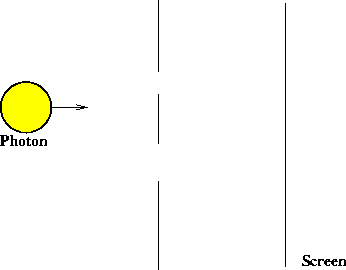
And now Occultism puts to Science the question: "is light a body, or is it not?"
-- spiritualist Mme. Blavatsky, 1888
Classical physics, dividing everything into matter and energy, had an easy understanding of these two things: matter behaved as if it were made of tiny particles, and energy behaved as if it were made of waves.
Particles are tiny specks of stuff. They exist at a particular location at any given time, and move around like colliding billiard balls, subject to the laws of motion for speed, acceleration, and so forth.
Waves, on the other hand, are like ocean waves, not in one particular spot but extending over a range of both space and time. Waves have a frequency (how many crests of the wave pass a particular spot each second), and a wavelength (the distance between two crests).
How does this fit with the modern discovery that energy and mass are the same thing? It turns out that both matter and energy sometimes behave as particles, and sometimes behave as waves.
It is easy to think of matter as particles, because when we see a bowling ball, for example, it appears to be in one place, and can roll around and hit things.
At the very tiny level, bits of matter like electrons also behave like particles. For example, the electrical resistance of a piece of wire arises from the fact that electrons collide with other particles in the wire. If electrons were waves, they wouldn't collide in the same manner, and there would be no such thing as electrical resistance.
On the other hand, electrons can behave like waves. In one experiment, a beam of electrons shone through a grating results in a diffraction pattern. Only considering the electron as a wave can explain diffraction; particles can't show diffraction patterns.
It is easy to think of energy as a wave. Light exhibits familiar traits such as refraction, diffraction and interference. Only waves have these characteristics; particles do not.
On the other hand, light can behave like particles. Experiments which collide light with small atoms result in a changed frequency, which is possible only if light is made of particles that lose energy when they collide with other particles. At a more familiar level, automatic door openers, burglar alarms and photocopiers all rely on the behavior of light as particles.
An interesting experiment demonstrates how light can exhibit either particle or wave behavior, but not both. Scientists shine light through a barrier with two slits, such that only one light particle ("photon") at a time passes through, like this:

If a measuring device is placed on the screen, the result is a diffraction pattern -- portions of the wave pass through both slits, are bent and produce the pattern. This can be done only by a wave.
However, if a photon detector is placed at one of the slits, then a photon is detected half the time and not detected half the time, but there is never a diffraction pattern! Simply designing the equipment to look for light as particles makes the wave behavior disappear!
If an experiment is designed to look for waves, it will find waves, and no particles. If it is designed to look for particles, it will find particles, and no waves. No experiment can be designed to detect both waves and particles simultaneously.
If things aren't simply particles, aren't simply waves, and aren't both particles and waves, what are they?
"Particle" and "wave" are not aspects of reality, but mental tools to help us describe certain types of behavior. Things aren't particles or waves; we don't know what they are, but we can design experiments such that they behave either as particles, or as waves.
With the discovery of wave/particle duality, the very foundations of science are called into question.
If things can behave in seemingly incompatible ways depending on the design of an experiment, can any experiment be truly objective? No matter how well we learn about how something behaves, there will always be the possibility of wildly different behaviors that we haven't looked for in the right way. How entitled are we to make claims about what reality "is" apart from what it "seems"?
The scientific method attempts to prove or disprove theories. If the design of the experiment affects the outcome, and other behaviors are always possible, can any theory be proved completely true or false?
In a way, this does not strike to the heart of science. The scientific method has always maintained that no theory is ever considered 100% true, but always subject to revision by further evidence. However, this does suggest that our pride in science's successes should never be viewed without its reflection: the humility of realizing how much we do not know.
Next: Mirror Image
For Further Exploration
The technically minded and curious can browse these sources elsewhere on the Web: